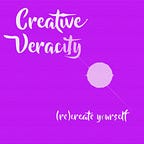Koan Kreativity X
Using Ancient Wisdom to Inspire Modern Creativity
Presented as either a riddle or tale, the koan is instrumental to the Zen student’s path to enlightenment; by opening and freeing the mind from both outer and inner restrictions, the “empty mind” of the Zen student is more open to insight and realization that could be achieved in no other way.
As artists and creative people we, too, need the benefit of an “empty mind.” Our own creative insights and realizations become more tangible and workable when we clear away the clutter of fear, apathy, negativity, and all other potentially destructive restrictions that we may have learned in our lives.
__________
What Are You Doing? What Are You Saying?
In modern times a great deal of nonsense is talked about masters and disciples, and about the inheritance of a master’s teaching by favorite pupils, entitling them to pass the truth on to their adherents. Of course, Zen should be imparted in this way, from hear to heart, and in the past it was accomplished. Silence and humility reigned rather than profession and assertion. The one who received such a teaching kept the matter hidden even after twenty years. Not until another discovered, through personal need, that a real master was at hand was it learned that the teaching had been imparted, and even then the occasion arose quite naturally and the teaching made its way in its own right. Under no circumstance did the teacher claim, “I am the successor of So-and-so.” Such a claim would prove quite the contrary.
The Zen master Mu-nan had only one successor. His name was Shoju. After Shoju had completed his study of Zen, Mu-nan called him into his room. “I am getting old,” he said, “and as far as I know, Shoju, you are the only one who will carry on this teaching. Here is a book. It has been passed down from master to master for seven generations. I have also added many points according to my understanding. This book is very valuable, and I am giving it to you to represent your successorship.”
“If the book is such an important thing, you had better keep it,” Shoju replied. “I receive your Zen without writing and am satisfied with it as it is.”
“I know that,” said Mu-nan. “Even so, this work has been carried from master to master for seven generations, so you keep it as a symbol of having received the teaching. Here.”
The two happened to be talking before a brazier. The instant Shoju felt the book in his hands he thrust it into the flaming coals. He had no lust for possessions.
Mun-nan, who never had been angry before, yelled: “What are you doing!”
Shoju shouted back: “What are you saying!”
* * *
We can learn and be inspired by other artists and creative people but, ultimately, our creativity belongs to ourselves. We alone shape and design our own creative universes, and we alone are the ones who ultimately must do our own creative work.
We must find the strength and courage to become our own mentors. We must rely on — and learn from — our own creative intuition on the journey to “becoming” creative, with the realization that the journey never ends.
As Julia Cameron points out in her book, The Artist’s Way: “When we respond to art we are responding to its resonance in terms of our own experience. We seldom see anew in the sense of finding something unfamiliar. Instead, we see an old in a new light.”
The best mentors are those who guide and support us on our own paths, and not their own.
